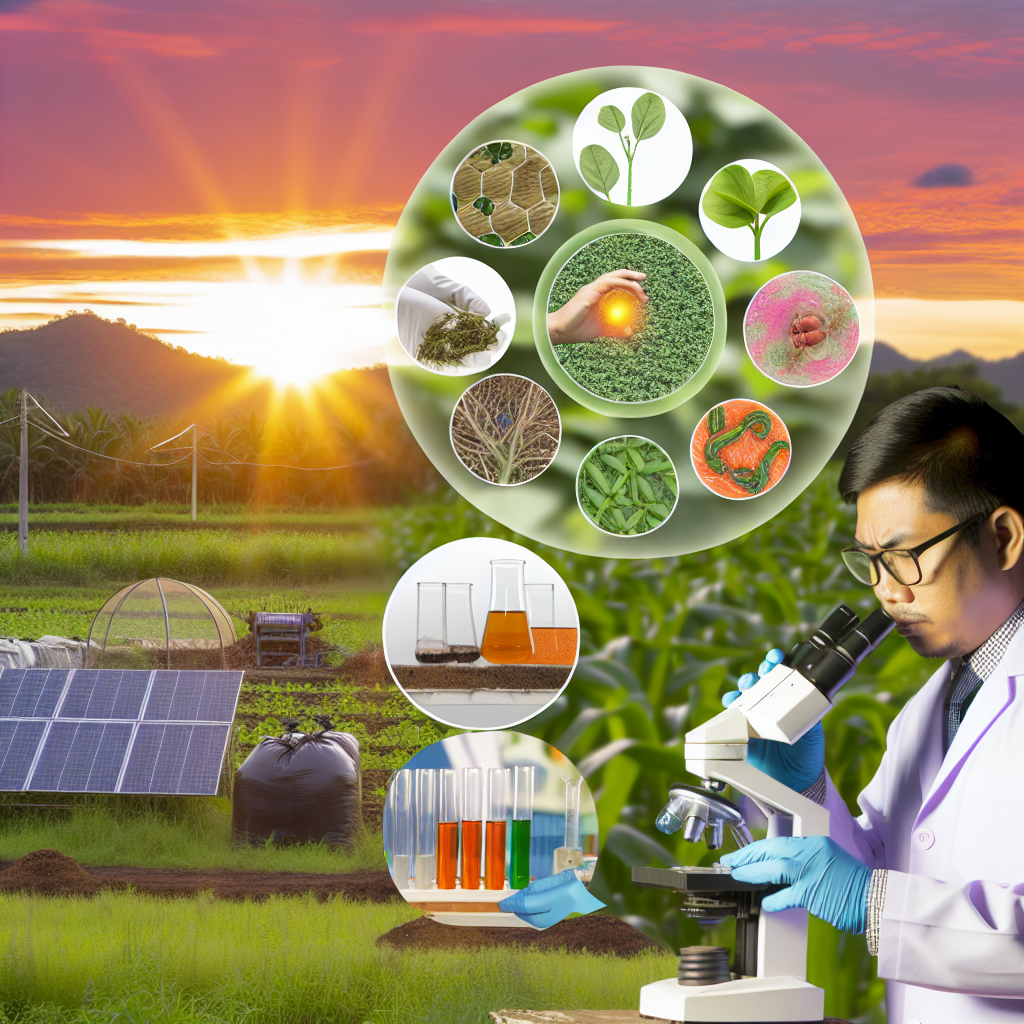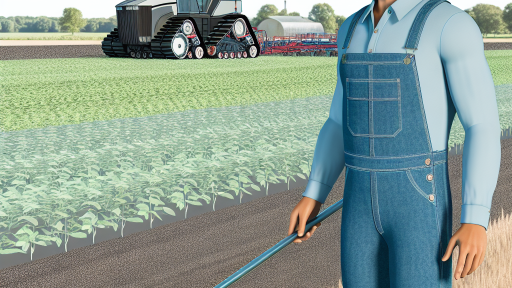Introduction to Biodiversity and Sustainable Food Production
Biodiversity plays a crucial role in sustainable food production.
It encompasses the variety of life forms on Earth.
These forms include plants, animals, fungi, and microorganisms.
A healthy ecosystem relies on diverse species to function effectively.
Moreover, biodiversity increases the resilience of agricultural systems.
It allows farms to withstand environmental stressors like climate change.
Additionally, biodiversity brings numerous benefits to food production.
These benefits include enhancing soil fertility and pest control.
Different species contribute unique nutrients back to the soil.
Furthermore, they assist in pollination, which is vital for many crops.
The Interconnection Between Biodiversity and Sustainability
The link between biodiversity and sustainability is evident in agriculture.
Sustainable practices help maintain a rich variety of crops and livestock.
This variety is essential for food security and nutrition.
Farmers who embrace biodiversity often enjoy improved yields.
They also face fewer pests and diseases in diverse systems.
Transform Your Agribusiness
Unlock your farm's potential with expert advice tailored to your needs. Get actionable steps that drive real results.
Get StartedConsequently, this reduces the need for chemical inputs.
Biodiversity thus contributes to healthier ecosystems and communities.
Challenges to Biodiversity in Food Production
Despite its importance, biodiversity faces significant threats.
Urbanization and industrial agriculture lead to habitat destruction.
These activities endanger both wild species and domestic varieties.
Climate change also poses a risk, altering habitats and ecosystems.
Moreover, monoculture practices can reduce genetic diversity on farms.
These pressures create a cycle that threatens food security.
Strategies to Enhance Biodiversity in Food Systems
Encouraging species diversity is crucial for sustainable food systems.
Farmers can adopt agroecological practices to achieve this goal.
This includes crop rotation and polyculture farming techniques.
Integrating cover crops also promotes soil health and biodiversity.
Additionally, creating habitats for beneficial insects can be effective.
Community involvement in local agricultural practices fosters commitment.
Therefore, education about biodiversity’s role is essential for farmers.
The Role of Biodiversity in Ecosystem Services: Supporting Agriculture
Understanding Ecosystem Services
Biodiversity significantly contributes to various ecosystem services.
These services support agricultural productivity and sustainability.
They include pollination, soil health, and nutrient cycling.
Moreover, biodiversity enhances resilience against pests and diseases.
A diverse ecosystem can adapt better to changing conditions.
Importance of Pollinators
Pollinators play a crucial role in food production.
They help in the reproduction of many crops and wild plants.
For instance, bees contribute to the pollination of fruits and vegetables.
Without them, many food sources would diminish.
Showcase Your Farming Business
Publish your professional farming services profile on our blog for a one-time fee of $200 and reach a dedicated audience of farmers and agribusiness owners.
Publish Your ProfileConserving habitats for pollinators is essential for agriculture.
Soil Health and Biodiversity
Biodiversity enriches soil health and fertility.
Diverse plant roots promote a healthy soil structure.
Additionally, soil microorganisms enhance nutrient availability.
They decompose organic matter and recycle nutrients effectively.
Healthy soil leads to improved crop yields and quality.
Nutrient Cycling
Diverse ecosystems facilitate efficient nutrient cycling.
Different species contribute to breaking down organic material.
This process enriches the soil with essential nutrients.
Consequently, crops receive necessary resources for growth.
Thus, biodiversity directly influences food production and sustainability.
Pest and Disease Resistance
Diverse ecosystems provide natural pest control.
Predators and parasites help manage pest populations.
Additionally, crop diversity can reduce disease spread.
Planting varied crops strengthens resilience to diseases.
This approach reduces the need for chemical pesticides.
Conserving Biodiversity for the Future
Preserving biodiversity is essential for future generations.
It ensures sustainable food production systems.
Conservation strategies can involve preserving habitats.
Farmers can adopt practices that support local ecosystems.
Ultimately, a collaborative effort is necessary to bolster biodiversity.
How Genetic Diversity Enhances Crop Resilience to Pests and Diseases
The Role of Genetic Diversity
Genetic diversity plays a crucial role in agriculture.
It provides a range of traits essential for survival.
Farmers benefit from numerous crop varieties.
These varieties can withstand different environmental stresses.
For instance, they may tolerate drought or flooding conditions.
Enhanced Resistance to Pests
Genetic diversity enhances resistance to pests.
Diverse crops attract a variety of beneficial insects.
These insects help control pest populations naturally.
Furthermore, specific traits in crops can deter pests.
For example, some plants produce natural repellents.
Improved Disease Resistance
Diversity in crop genetics also improves disease resistance.
Some crop varieties contain genes that resist specific pathogens.
This resistance limits the spread of diseases in fields.
Healthy plants contribute to stronger ecosystems.
They help maintain agricultural productivity over time.
Real-World Examples
Legume varieties demonstrate the benefits of genetic diversity.
Research shows they can resist root rot effectively.
Another example includes ancient wheat varieties.
These wheats show resistance to certain fungal diseases.
Showcase Your Farming Business
Publish your professional farming services profile on our blog for a one-time fee of $200 and reach a dedicated audience of farmers and agribusiness owners.
Publish Your ProfileAdopting Diverse Practices
Farmers can adopt varied agricultural practices to enhance diversity.
Crop rotation is a common method that improves soil health.
This practice reduces pest buildup and disease spread.
Moreover, intercropping can increase biodiversity on farms.
By planting different crops together, farmers can boost resilience.
Delve into the Subject: 5 Sustainable Farming Techniques That Are Changing the Game
The Interconnection Between Biodiversity and Soil Health
Understanding Biodiversity’s Role
Biodiversity plays a crucial role in maintaining healthy soil ecosystems.
It involves various organisms, including plants, animals, and microbes.
These organisms contribute to the soil’s fertility and structure.
Healthy soil supports diverse crops essential for sustainable food production.
Additionally, biodiversity enhances the resilience of agricultural systems.
Soil Health Indicators
Several indicators reveal soil health and biodiversity levels.
These include organic matter content, nutrient availability, and microbial activity.
Higher organic matter improves soil structure and water retention.
This, in turn, benefits plant growth and nutrient cycling.
Microbial diversity is vital for disease suppression and soil nutrient delivery.
Practices for Boosting Biodiversity
Farmers can implement various practices to enhance biodiversity.
Crop rotation adds diversity and boosts soil health over time.
Cover crops reduce erosion and improve nutrient cycling.
Creating biodiversity-rich habitats like hedgerows supports beneficial insects.
Integrating livestock can also enhance soil organic matter through manure.
Long-Term Benefits
Increased biodiversity leads to improved soil health over the long term.
This improvement fosters sustainable agricultural practices.
Consequently, it promotes food security by ensuring reliable yields.
Ultimately, biodiversity contributes to a more resilient food production system.
Healthy soils support diverse ecosystems, benefiting both farmers and consumers.
Uncover the Details: Eco-Friendly Farming: How to Cut Costs and Save the Planet
Biodiversity’s Contribution to Nutritional Diversity in Food Systems
Importance of Nutritional Diversity
Nutritional diversity enhances food security and health.
It ensures that individuals receive a wide range of nutrients.
Various foods contribute to a balanced diet.
Consequently, diverse food production is vital for public health.
Role of Biodiversity in Food Systems
Biodiversity strengthens food systems against pests and diseases.
It increases resilience of crops and livestock to climate changes.
Moreover, diverse agricultural systems can enhance ecosystem services.
These services include pollination, nutrient cycling, and soil fertility.
Examples of Nutritional Diversity
Crops like quinoa and amaranth provide essential amino acids.
They are excellent substitutes for traditional grains.
Furthermore, foraging for wild plants adds unique nutrients.
This practice reconnects communities with local ecosystems.
Enhancing Local Food Systems
Supporting local biodiversity fosters nutritional diversity.
Showcase Your Farming Business
Publish your professional farming services profile on our blog for a one-time fee of $200 and reach a dedicated audience of farmers and agribusiness owners.
Publish Your ProfileFarmers can grow a variety of plants rather than monocultures.
This approach improves diet quality and reduces reliance on imports.
Additionally, local foods often retain more nutrients than shipped produce.
Challenges and Opportunities
Challenges include loss of traditional crop varieties.
Modern agricultural practices often prioritize uniformity.
However, there are opportunities to revitalize local varieties.
Community seed banks can preserve heritage seeds effectively.
Engaging consumers in biodiversity initiatives fosters support.
Explore Further: The Rise of Zero-Waste Farms: A Blueprint for Sustainability

Case Studies: Successful Integration of Biodiversity in Sustainable Farming Practices
Innovative Crop Rotation in Florida
In Florida, farmers employ innovative crop rotation methods.
This practice enhances soil health and fertility.
Additionally, it encourages biodiversity in agricultural ecosystems.
Crops like corn, beans, and squash benefit from this method.
Farmers report significant yields and reduced pest issues.
Organic Practices in California
California farmers embrace organic practices to boost biodiversity.
They utilize cover crops to improve soil quality.
These crops also attract beneficial insects to combat pests.
Thus, farmers experience healthier crop growth and higher profits.
Moreover, communities appreciate the reduction in synthetic chemicals.
Agroforestry in Brazil
Brazilian farms adopt agroforestry systems to promote biodiversity.
This method integrates trees with crop and livestock production.
Such diversification enhances biodiversity and protects natural resources.
Farmers witness improved crop resilience to climatic changes.
Furthermore, they enjoy an additional income from tree products.
Pollinator Habitats in Australia
In Australia, farmers establish pollinator habitats to boost yields.
These habitats support bee populations essential for pollination.
Farmers report improved crop quality and increased harvests.
Additionally, the habitats encourage local wildlife diversity.
This practice benefits both agriculture and the environment.
Community Supported Agriculture in Canada
In Canada, Community Supported Agriculture (CSA) connects farmers and consumers.
Members subscribe to receive seasonal produce directly from farms.
This relationship fosters a commitment to sustainable practices.
Farmers are encouraged to diversify their crops, promoting biodiversity.
Consumers benefit from fresh, sustainably-grown food.
Learn More: Why Crop Rotation Is Crucial for Sustainable Soil Health
Challenges and Threats to Biodiversity in Agricultural Systems
Loss of Habitat
Habitat destruction poses a significant threat to biodiversity.
Expanding agricultural land leads to deforestation and ecosystem loss.
Moreover, urbanization continues to encroach on natural habitats.
This loss reduces the number of species available for food production.
Pesticide and Chemical Use
The extensive use of pesticides negatively impacts non-target species.
Showcase Your Farming Business
Publish your professional farming services profile on our blog for a one-time fee of $200 and reach a dedicated audience of farmers and agribusiness owners.
Publish Your ProfileChemicals can disrupt ecosystems and harm beneficial insects.
Additionally, water contamination affects aquatic biodiversity.
Ultimately, these practices threaten the sustainability of agriculture.
Genetic Homogeneity
Reliance on a few high-yield crop varieties increases vulnerability.
This genetic uniformity makes crops susceptible to pests and diseases.
As a result, farmers face decreased resilience in changing climates.
Biodiversity enhances resistance to these threats by providing diversity.
Climate Change
Climate change introduces new challenges for agricultural biodiversity.
Shifting weather patterns threaten traditional farming practices.
Extreme weather events can disrupt food production cycles.
Additionally, some species may struggle to adapt to changing conditions.
Invasive Species
Invasive species disrupt local ecosystems and agricultural systems.
These species often outcompete native flora and fauna.
Farmers must expend resources to manage these threats effectively.
Invasive pests can lead to significant crop losses and financial strain.
Socio-Economic Factors
Global trade practices affect local farming diversity.
Market demands often prioritize homogeneous products.
This pressure discourages the cultivation of diverse crops.
As a result, farmers may opt for cash crops over diverse planting.
Strategies for Promoting Biodiversity in Modern Agriculture
Utilizing Crop Diversity
Farmers should plant a variety of crops in their fields.
This practice enhances resilience against pests and diseases.
Moreover, diverse crops can improve soil health and stability.
Organizations like GreenFields Initiative promote polyculture techniques.
These techniques encourage farmers to embrace a wider range of plants.
Employing Organic Farming Practices
Organic farming supports biodiversity by avoiding synthetic chemicals.
Farmers can use natural fertilizers and pest control methods.
This promotes a healthy ecosystem for beneficial insects and plants.
Furthermore, organic farms often preserve surrounding habitats.
Companies such as EcoHarvest offer training for organic techniques.
Integrating Agroforestry Systems
Agroforestry combines agriculture with tree planting.
This creates habitats for wildlife while producing food for humans.
Additionally, trees can improve soil quality and retain moisture.
Studies by the Agroforestry Research Institute show significant benefits.
Farmers can increase yield by incorporating fruit or nut trees.
Implementing Sustainable Land Management
Sustainable land management practices are essential for promoting biodiversity.
Methods like crop rotation help maintain soil health over time.
Furthermore, cover cropping protects the soil from erosion.
Organizations such as the Land Restoration Network promote these strategies.
They encourage community involvement in sustainable practices.
Encouraging Community Involvement
Communities play a crucial role in enhancing agricultural biodiversity.
Showcase Your Farming Business
Publish your professional farming services profile on our blog for a one-time fee of $200 and reach a dedicated audience of farmers and agribusiness owners.
Publish Your ProfileLocal farmers can collaborate on biodiversity initiatives.
Workshops and awareness programs educate about the importance of diverse crops.
Moreover, community gardens can showcase biodiversity directly.
Partnerships with schools and nonprofits promote hands-on learning opportunities.
Utilizing Technology for Biodiversity Tracking
Technology can aid in monitoring biodiversity levels in agriculture.
Tools like GIS mapping help farmers assess their land effectively.
Moreover, mobile apps can track wildlife and plant species in fields.
Organizations such as AgriTech Solutions offer innovative tracking tools.
These advancements enable informed decision-making for sustainable practices.
Additional Resources
Our global food system is the primary driver of biodiversity loss




